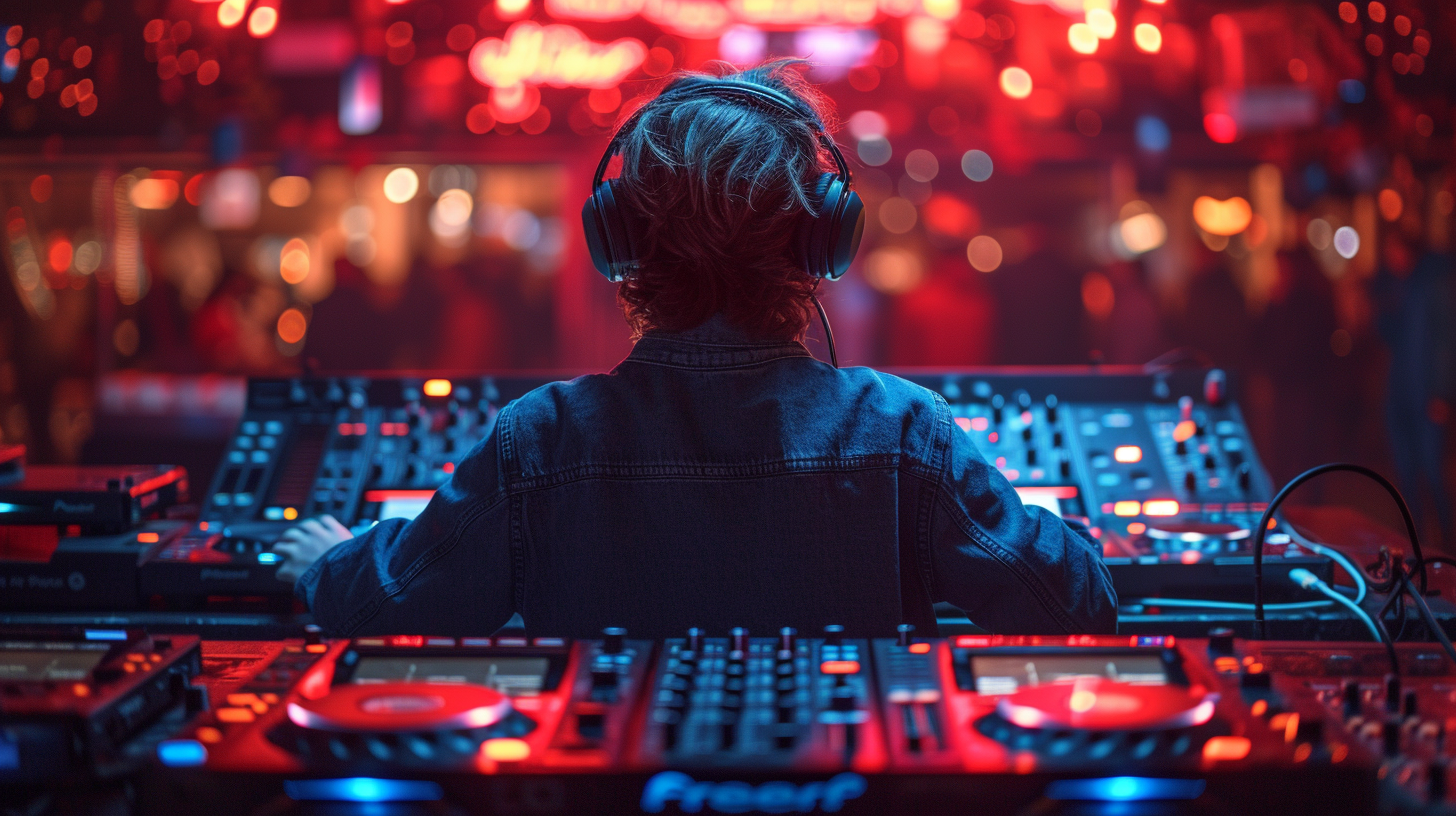Struggling with messy DJ transitions and trainwreck mixes without a headphone cue preview? Learning how to use headphones properly with your controller is a game-changer.
Using headphones when DJing allows you to beatmatch tracks smoothly, cue up the perfect mix points, and create professional blends every time.
Let’s explore some best practices for setup, configuration, monitoring techniques, and health considerations when using headphones with DJ controllers so you can elevate your performances.
Why Do You Need Headphones for DJing?

Using headphones when DJing is crucial for previewing upcoming tracks in your mix. This allows you to queue songs efficiently, match tempos precisely via beatmatching, and identify the best moments to transition between tracks smoothly. We’ll explore these essential monitoring techniques in more detail below. But first, let’s cover some key headphone types and equipment considerations.
Why Use Headphones with a DJ Controller

Using high-quality headphones with your DJ controller setup is highly recommended for a few key reasons. One of The most important reasons to use headphones as you DJ is that they allow you to preview tracks before airing them through the main speakers or PA system. As most digital DJ software works on the concept of decks, with one or two decks live while others allow you to preview upcoming tracks, you’ll want to cue these up in your headphones first to check that they are beatmatched properly and ready to transition at the right moment. Headphones are absolutely essential if you want to beatmatch your tracks instead of just playing them out. It takes practice to beatmatch by ear, and your headphones give you the focused environment to master this crucial DJ skill.
Finally, using headphones as you DJ enables you to smoothly transition from one track into the next. You can use your headphones to identify the perfect mix-out and mix-in point between the live track playing out on the speakers and the next track you have lined up and ready to launch once the timing is right. Without headphones to preview the upcoming track, you would have to mix songs together blindly. Needless to say, this leads to some trainwreck transitions! Using headphones is what gives DJs the confidence and control to create great mixes.
Headphone Types to Consider
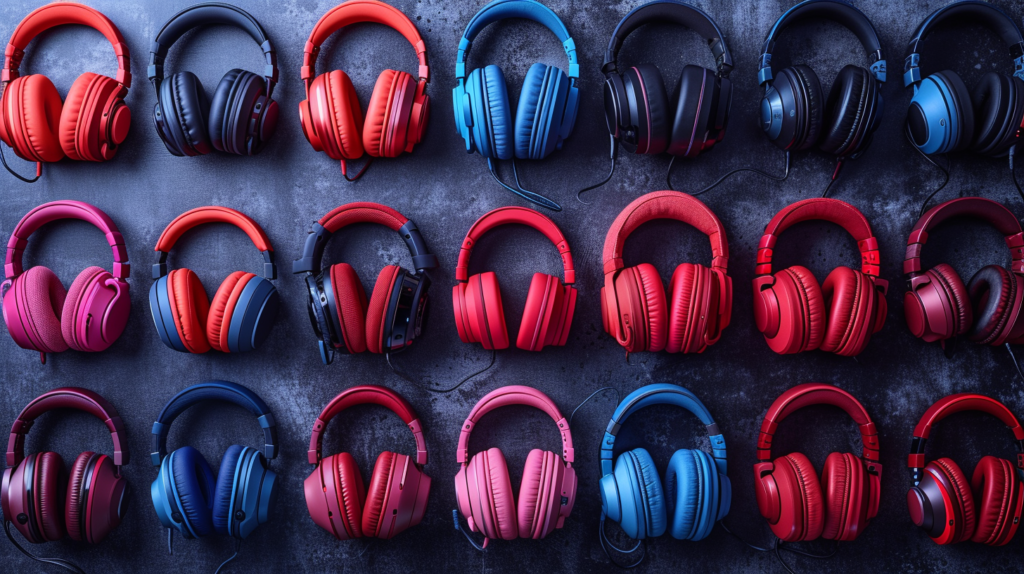
When purchasing headphones to use with your DJ controller, there are a few types and features that may better suit your DJing needs. Key considerations include whether an over-ear, on-ear, or in-ear headphone design is most practical and comfortable for your use case. You also need to determine if an open-back or closed-back headphone driver system will work best for your DJ listening requirements in terms of sound isolation and audio bleed. The frequency response range and impedance are other specifications to examine to ensure the headphones provide the balanced sound reproduction you need for monitoring tracks in the DJ booth.
Over-ear headphones, sometimes known as full-size headphones, have padded ear cups that fully enclose your ears. The over-ear design helps block out ambient noise and provide a robust bass response. Popular DJ headphones that utilize an over-ear wearing style include models such as the Sennheiser HD 25, Pioneer HDJ-X5, and Beats Pro. On-ear headphones, as the name suggests, have smaller ear cups that rest directly on your ears instead of around them. While less isolating than over-ear options, on-ear headphones may feel more comfortable for extended wear sessions. In-ear headphones, commonly referred to as earbuds as well, sit right inside your ear canal. Top DJ earbuds include the Shure SE846 and Etymotic ER4SR.
In terms of headphone driver types, closed-back models feature sealed ear cups that keep sound in and prevent audio bleed. The sound isolation of closed-back headphones makes them ideal for DJ use cases. Open-back headphones have perforations in the ear cups for increased ventilation and expansive sound. However, open-back models are more prone to audio leakage and are better suited for critical listening rather than DJ monitoring. Examining specifications like frequency response and impedance will give you further insight into audio quality. Wider frequency ranges with lower impedance tend to deliver optimal reproduction for monitoring tracks in DJ applications. However, if headphones have too low impedance without an amplifier, you may find the volume too low from some controllers. Do your homework to ensure the headphones match your setup.
Connecting Your Headphones
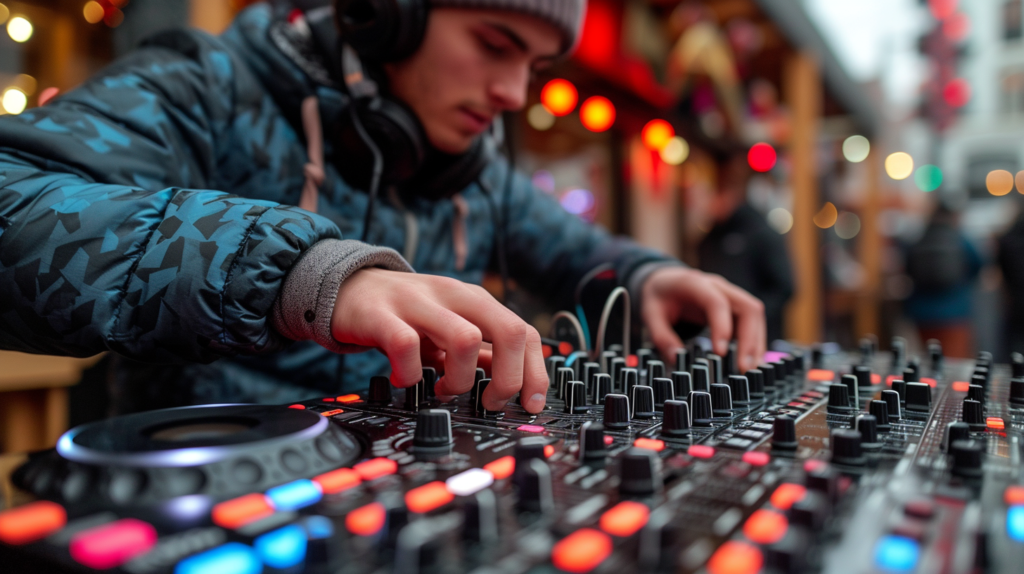
Connecting your headphones to your DJ controller is a straightforward process once you have a compatible model on hand. Most DJ controllers, whether all-in-one standalone units or DJ interfaces to use with laptop software, have a dedicated headphone output jack. This headphone port may be labelled as “Phones” or with a headphone icon on the controller. Simply plug your headphones into this output jack, often a 1⁄4” or 1⁄8” (3.5mm) socket, using the appropriate adapter if needed.
Once your headphones are plugged into your DJ controller, you can adjust the headphone mix and volume to fit your monitoring preference. Most controller hardware and DJ software has a knob, slider, or buttons to control the cue/master mix being sent to your headphones. Adjust this blend until you achieve the desired ratio between monitoring upcoming tracks versus hearing the live mix output from the speakers. You also have a headphone volume control on your DJ device or in the DJ program to turn the listening level up or down as needed. Start at a moderate volume to avoid damaging your hearing over long DJ sessions. Adjust this as required while DJing based on the ambient noise levels in your environment at the time.
Using Headphones for Monitoring and Previewing
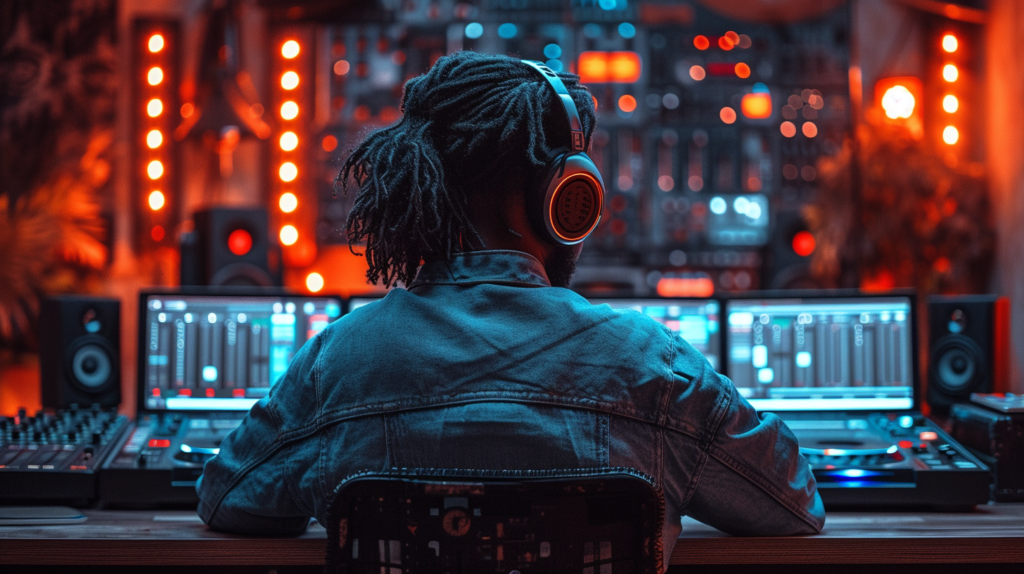
Using your DJ headphones for monitoring and previewing tracks is absolutely essential for smooth and seamless mixing. Your headphones serve as a focused listening zone, blocking out sounds from club speakers and chatter so you can solely concentrate on track transitions. One of the main monitoring techniques for DJs involves queueing up the next song you plan to mix in your headphones. You load the incoming track into a free channel or deck in your DJ software. With your headphones on, you can preview this song, getting a feel for the rhythms, vocals, or other elements. Use your cue points to determine an appropriate mix-in spot, usually on a bass drum or snare hit.
From here, you then employ your headphones to beatmatch the incoming track against the currently playing song audible from the speakers. You adjust the tempo slider or pitch fader until their BPMs align and the beats play in perfect sync together in your headphones. Some advanced controllers even have dual headphone inputs, allowing you to monitor the master output in one earcup and the cued track in the other earcup. This makes beatmatching by ear even more precise. Once your next song is beatmatched and lined up, keep your headphones on to smoothly transition across on the downbeat. Your headphones help identify the exact moment to cut or blend between the two tracks. Using headphones is what gives you the ability to confidently DJ, preview arrangements, and create professional blends.
Headphone Features to Utilize
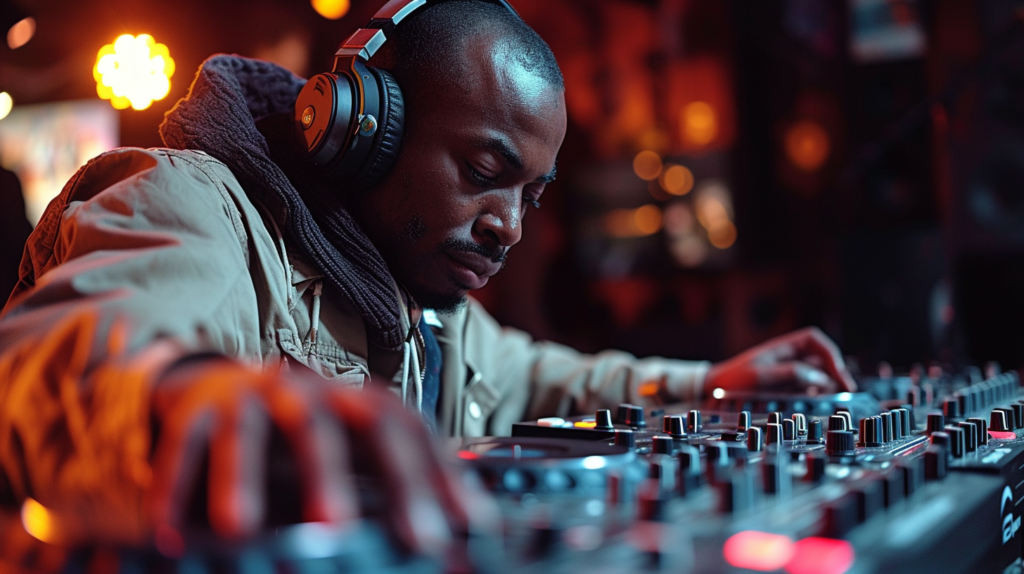
Today’s leading DJ headphones incorporate useful features that further improve their functionality and ergonomics for mixing applications. Take note of any swiveling or rotating ear cups when evaluating headphone options. Having ear cups that pivot side to side or flip up allows greater freedom of movement and single-ear monitoring flexibility. This way you can flip open one ear cup to hear the main speaker output while simultaneously using the other closed ear cup to preview the next song. Models like the Sony MDR-7506 have cups that do a complete 180-degree rotation for ultimate versatility. Some manufacturers also utilize coiled headphone cables rather than straight cables. The expanded length of coiled cables allows for greater movability, enabling you to move back and forth between your DJ gear and mixer with ease during sets.
Consider the overall robustness and replaceability of key components too. Headphones used for DJing get put through a lot of wear and tear. Examine construction materials closely for durability to withstand being transported from gig to gig. User-replaceable parts like ear pads and cable connections will further expand headphone lifespan so you can replace only the broken components rather than the whole unit if damage occurs. Other premium headphone models even allow you to customize and design your own look. Personalization can help you easily identify your headphones in crowded booths and prevents theft. Just be sure to pick materials suited for extensive use. Using headphones for DJing stresses them to the limits, so factor their construction, longevity, and care requirements into purchase decisions.
Best Practices While DJing with Headphones
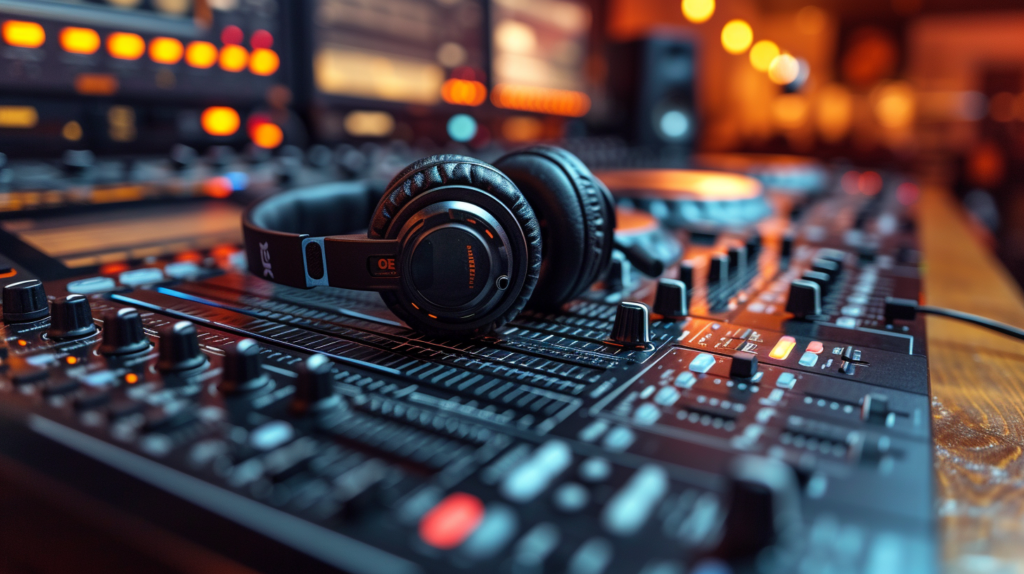
When using headphones in your DJ performances and mixes, there are a few best practices all DJs should follow. The number one rule is to avoid excessive volume exposure from your headphones over prolonged periods. Hearing damage from headphones is an ever-present occupational hazard for performers in the music industry. Be sure to keep headphone volume at moderate, safe levels whenever possible. If you must turn up the pre-listen level loud to hear over a noisy club, try to remove your headphones completely in between mix transitions to give your ears a break. Setting an upper volume limit on your headphone output chain also encourages more reasonable listening habits.
You should also strive to develop consistent cueing, monitoring, and transition workflow habits with your headphones over time. Whether you prefer to always monitor the incoming track in your left ear and the house mix in your right ear or take a different approach, create routines that work best for your DJ style. Sync your movements to check channel levels, adjust EQs, hit play, and crossfade between tracks with deliberate headphone listening focused on smooth transitions. Use your headphones as an integral tool in your mixing process from the first track’s downbeat to the last song’s outro.
Always remember to use your headphones effectively in conjunction with other sound monitoring like booth monitors or PA speakers as well. This allows you to balance solo headphone pre-listening with getting natural acoustic feedback of how your live mixes actually sound. Do not rely exclusively on your headphones without periodically checking levels from the main speakers. This gives you a complete picture to tweak the spectral balance and volume as needed. Follow these best practices and your headphones will transform into an invaluable DJ tool.
Conclusion
In conclusion, using high-quality headphones is an essential piece of gear for DJs. Connect your headphones to the dedicated output on your controller, set an appropriate cue/master mix, and utilize them to preview tracks, nail precise beatmatching, and execute clean transitions between songs. Following best practices like establishing workflow routines, avoiding excessive exposure, and incorporating booth monitors will allow you to get the most out of your headphones. With the right headphones and some dedicated practice, you can take your DJ mixing skills to the next level.
